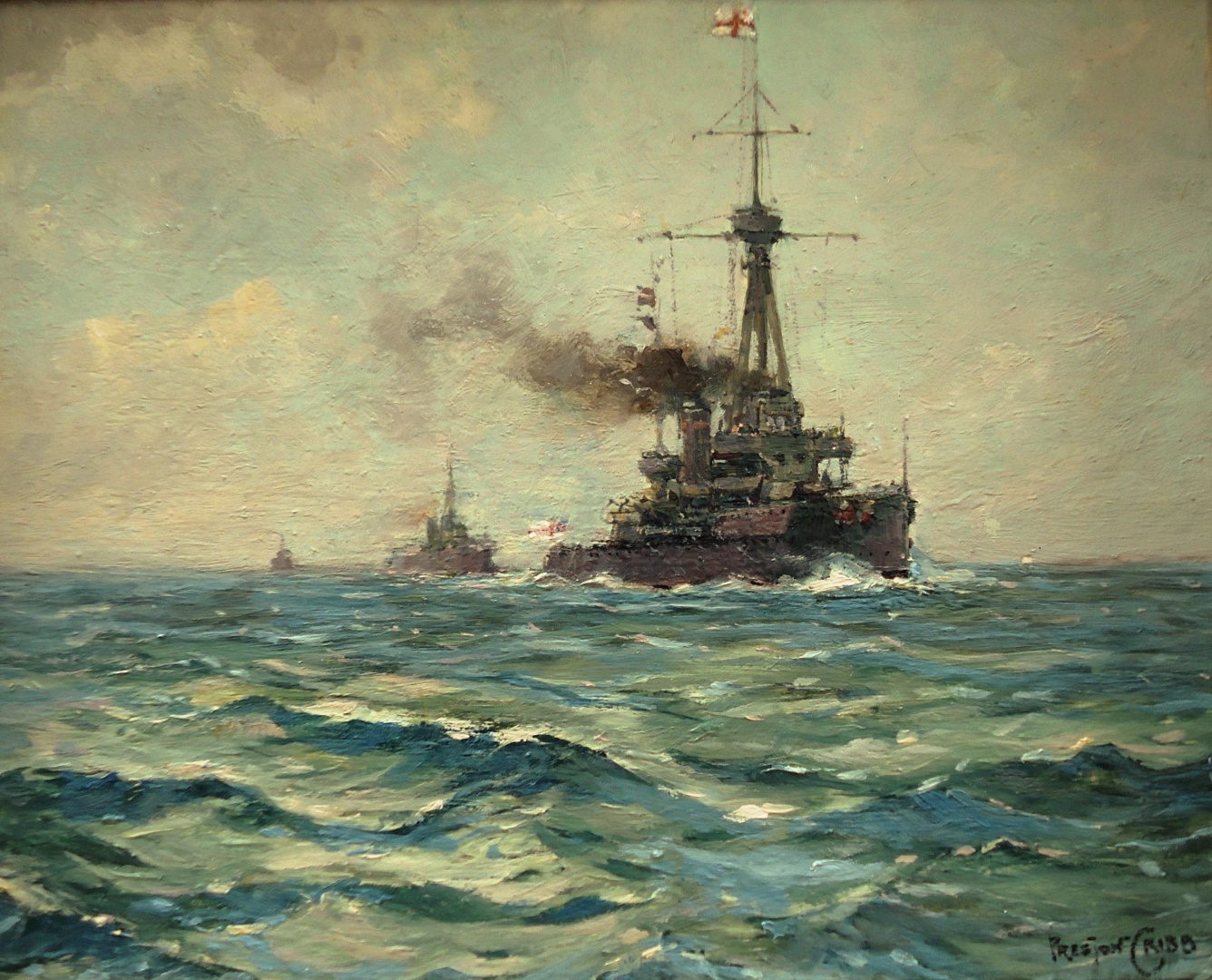HMS COLOSSUS Leading the 2nd Div, Home Fleet, 1911/1912
Miscellaneous. Oil on board, signed Preston Cribb (LR); undated.
8 x 10 ins (20.2 x 25.40 cms) approx
Price on application
This original has been sold and is no longer available.
HMS COLOSSUS and her sister HERCULES were both laid down on the same day in July 1909, some three and a half years after HMS DREADNOUGHT by which time the dreadnought concept had been modified considerably. Broadside A arcs had been improved over DREADNOUGHT by staggering the side turrets, breaks in the superstructure enabling the turrets to fire across the ships; the after turrets were superimposed one above the other and cruising turbines had been fitted enabling fuel comsumption at all but maximum power to be reduced, a refinement not incorporated in DREADNOUGHT. The ships were some twenty feet longer and were the first dreadnoughts to be fitted with 21 inch torpedo tubes. Where no improvement was apparent, however, was over the vexed question of the siting of the main spotting top vis a vis the funnels!
Identified as a problem in DREADNOUGHT because the spotting top, perched on the mainmast which was abaft the for'rard funnel, was invariably smoked out by that funnel, the unsatisfactory arrangement, inexplicably, was carried forward into this class. A related issue was that the compass platform was also badly affected by smoke and sulphur fumes if the relative wind was for'rard of the beam and in 1912 this was partially ameliorated by the fore funnel being raised by some 15 feet. But that did not, of course, help the poor spotting top team who now found the emitter of the smoke even closer to them than before the funnel was raised!
Although the painting is undated by Cribb, the heightening of the for'rard funnel was carried out in 1912: both funnels in this painting are of similar height and so COLOSSUS is painted here in her 1911-1912 guise under the command of Captain Dudley de Chair. The ship's Executive Officer, Commander Oliver Backhouse, had - as is still customary - joined the ship when she was still building to enable many of the niggles that arise during this important time to be sorted out. This dating, 1911-1912, is reinforced by the fact that the red funnel bands of the two ships since commissioning in the summer of 1911 (one red on each of COLOSSUS', two red on each of HERCULES'), were removed in 1912. We are looking at a spanking new COLOSSUS who because of that very fact may just be taking a vice-admiral to sea to witness just what this new battleship was all about. The matter of the vice-admiral's flag at the foremast - clearly shown here by the artist - is worth mentioning as during the period from first commissioning until August 1914 and the outbreak of war, COLOSSUS was a private ship, never a flagship. Was the admiral's flag artist's license or was he painting an actual event as hinted at above? And talking of artist's license, Cribb has made the very most of the after stump 'mast' (in reality two boats derricks), shown here to be quite a substantial structure!
So what about the artist's credentials? Preston Cribb (1876-1933) is a little known artist today and his style is somewhat evocative of Cecil King's (1881-1942; see his work on this website). He was born in Portsmouth, subsequently moved to Birmingham and exhibited his work extensively in the first quarter of the the last century at the Royal Academy, the Royal Institute of Oil Painters, the Royal Society of British Artists and the Royal Society of Marine Artists. As far as this painting is concerned Cribb has created a very attractive oil painting: warships which are, apart from that after mast on COLOSSUS, very well observed and painted in pleasing detail in line ahead on a convincing and realistic sea. Despite the fact that he seemed to know his onions it's a pity that so little of his work is to be found today.
